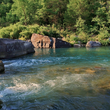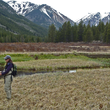An Alabama mining company that wants to use a dragline system to extract titanium, staurolite and zircon from beneath Trail Ridge, a geologic feature that helps contain the iconic blackwater swamp of the Okefenokee National Wildlife Refuge, received draft permits on Feb. 9 to do just that.
The refuge, home to the largest wilderness area in the Southeast (just shy of 354,000 acres), represents some of the last intact blackwater swamp environments in the United States. It is home to everything from rare red-cockaded woodpeckers, white-tail deer, black bear, river otter and, of course, some 12,000 to 15,000 alligators. It’s also home to wild turkeys, migratory sandhill cranes and other waterfowl, as well as numerous reptiles, including rare gopher tortoises and indigo snakes, amphibians and four species of carnivorous plants.
Its fishery is just as diverse. The swamp’s dark, tannin-stained waters are home to panfish like flyers and warmouth, chain pickerel, all of which are popular with anglers in the region. It’s also home to the surly bowfin — a prehistoric fish with a cult following among fly fishers.
The draft permits issued to Twin Pines Minerals LLC — one that would allow surface mining; an air-quality permit to allow for emissions during the mining process; and a permit for the use of groundwater — come after significant opposition to the plan to mine Trail Ridge.
The ridge serves to contain the water in the refuge and help keep the swamp intact. The Okefenokee is basically a giant rain barrel. It collects surface water from the surrounding drainages and then feeds two storied American blackwater rivers — the Suwannee, which flows south and west to the Gulf of Mexico, and the St. Marys, which flows east to the Atlantic Ocean.
Last year, the St. Marys river levels were already low thanks to a drought. Emily Floore, executive director of St. Marys Riverkeeper, worries that the mine could result in even lower levels, which could be disastrous to the river’s ecology and the ongoing recovery work being done for Atlantic sturgeon in the river.
Very little is known about the extremely rare fish – the St. Marys marks its southernmost documented range. It’s so rare and so secretive that biologists don’t even know for sure when it spawns or where in the river it spawns.
“It’s a big mystery,” said Floore, who was part of a research trip last year that captured two juvenile sturgeon from the tannic waters of the river. “Some think they spawn whenever water levels and conditions are just right, but nobody really knows.”
Hydrologists and biologists are concerned that the dragline mining operations, which would strip away the top layer of soil — trees and all — to get at the white sands that contain the desired commodities, will alter the fragile hydrology of the swamp. In fact, a cadre of 87 hydrologists, biologists, geologists and academics from colleges and universities around the country penned an open letter to the south Georgia community last year, expressing their concerns about the proposed mining operation.
“Digging up Trail Ridge and then replacing it post mining will mix the existing layered sands, clays, and organic matter,” the letter reads. “This makes Trail Ridge more porous and thus more conductive to water, lessening its ability to hold water. This will alter groundwater flows through Trail Ridge and possibly lead to permanently lower water levels in the swamp, depending on the spatial extent of such modification. The leakage through the modified Trail Ridge means that water pumped by the mining activity will largely derive from the Okefenokee Swamp.”

A dragline is, in its simplest form, a giant shovel dragged along the ground by two giant cables. In the case of the Twin Pines proposed mine, the dragline would excavate the soil on Trail Ridge up to 50 feet deep. The soil pulled away by the dragline would be used to contain water produced during the mining project, and, when mining is complete, the same soil would be used to backfill the site, minus, of course, the heavy sands containing the desired minerals. The mine site will impact about 600 acres of land on Trail Ridge.
The process leading to the issuance of the draft permits this month included a 60-day comment period early last year. During that period, GEDP received nearly 160,000 comments on the proposed mine project.
The comments ranged from hydrological concerns from the scientific community, including the very real possibility of reduced water levels, both in the swamp and in the St. Marys River. The river, shortly after leaving the swamp, becomes the border between Georgia and Florida. There were also concerns over air and water pollution, night-time light pollution and the impacts from the mine on the local economy due to reduced tourism as a result of the industrial activity. The GEDP issued its responses to those concerns in a 19-page document.
According to Defenders of Wildlife, a national non-profit group that is staunchly opposed to the mining project on the fringes of the swamp, the mine has the potential to devastate the local ecology, including the Okefenokee National Wildlife Refuge, which is being nominated by the National Park Service for United Nations Educational, Scientific and Cultural Organization’s World Heritage List (UNESCO) designation.
In late 2022, U.S. Secretary of the Interior Deb Haaland drafted a letter to Georgia Gov. Brian Kemp asking him to step in and block the state permitting process for fear the mine would negatively impact the hydrology of the refuge and the cultural history of the region, which is the ancestral home of the Muskogee Nation.
“The proposed mining activity in this area poses an unacceptable risk to the long-term hydrology and future of the swamp ecosystem and these cultural values,” Haaland wrote. “The U.S. Fish and Wildlife Service has communicated these concerns before and intends to submit further information outlining these serious consequences if the State moves forward with the permitting process.
“We are not alone in this assessment,” Haaland continued, “as some of the preeminent experts on this ecosystem and hydrology at the University of Georgia have also raised the alarm about the threat that this type of mining activity in this area poses to the swamp.”
The permits issued by the state, DOW claims, shows that the state of Georgia is willing to risk one of its greatest natural resources in favor of extractive industry.
“This is a tragic outcome for one of our nation’s most important national wildlife refuges and global treasures,” said DOW Southeast Program Director Ben Prater. “It is inconceivable to anyone who actually values Georgia’s environment to claim that this mine will not harm the critically important wetlands and wildlife of the Okefenokee ecosystem.
“We cannot allow greed and selfish corporate interests to consume our last wild places,” Prater continued. “EPD has one job. It must deny the permits."
The draft permits to mine Trail Ridge are not final. The public has until April 10 to submit comments to the GDEP — though the agency has acknowledged that it is failing to take steps to capture many comments submitted by the public. According to a message posted on the GDEP website, which reads "Due to the high volume of emails sent to this account, you may receive a bounce-back notification," some comments are being returned to sender, leaving concerned individuals with attempting to resubmit their comments as their only recourse. A virtual public meeting is planned March 5 via Zoom, but is limited to 1,000 participants.
Once the comments have been sorted and reviewed by GDEP, the state could issue final permits. It’s very likely, however, that these permits will be challenged in court by conservation groups fighting to protect the refuge.
“We are pleased that, after thorough evaluation of our application, EPD has issued draft permits for the demonstration mine,” said Steve Ingle, president of Twin Pines, in a prepared statement. “The exhaustive hydrology, geology, biology and herpetology studies, as we have said all along, have been validated. We expect stringent government oversight of our mining-to-reclamation project which will be fully protective of the Okefenokee Wildlife Refuge and the region’s environment.”
Requests to speak directly with Ingle or any Twin Pines official about the project were rejected.
The Okefenokee National Wildlife Refuge is visited more than 400,000 times by tourists every year, putting it in the top 20 destinations managed by the USFWS.






























Comments
Bill Sherer replied on Permalink
In your wildest dreams that doesn't even sound like a good idea! Where do some people come up with this stuff? Exploiting an important environmental site just because something is there just doesn't make any sense to me. These are not vital materials that we can't live without.
Capt AJ replied on Permalink
I was born in N. GA where mining has been practiced since Dahlonega old school prospective panning to vast scarring excavations occurring today. GA allows paper companies ON the Savannah River to extract Floridan Aquifer "the FA" (1 mile deep) permits taking drinkable water to make products instead of easily from the river. We drink the FA!!! Therefore, do not blame a business interest for asking to mine IF a State allows it... it's all on the State for not protecting the Okefenokee despite the concerns of potential hydrological and historical relevance of the aquatic ecosystem.
Pages